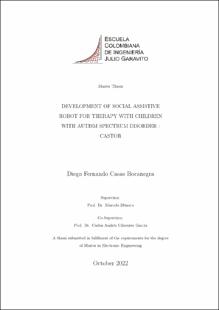| dc.contributor.advisor | Munera Ramírez, Marcela | |
| dc.contributor.advisor | Cifuentes García, Carlos Andrés | |
| dc.contributor.author | Casas Bocanegra, Diego Fernando | |
| dc.date.accessioned | 2023-02-22T20:31:08Z | |
| dc.date.available | 2023-02-22T20:31:08Z | |
| dc.date.issued | 2022 | |
| dc.identifier.uri | https://repositorio.escuelaing.edu.co/handle/001/2210 | |
| dc.description.abstract | The World Health Organization reports that 1 in 160 children have Autism Spectrum Disorder (ASD), a neuroatypical disorder characterized by social behavior difficulties, lack of attention, and language issues. Early diagnosis and therapy can lead to better long-term results for the individual. Recently, robots have been used in therapy to improve communication, recognition, and emotional skills. However, not all robots are suitable for this type of therapy due to their inability to physically interact with users. This study presents a proposal for a novel social robot designed specifically for children with ASD, using participatory design methodologies with caregivers, medical staff, and parents. The robot's design was evaluated through an ergonomic study and aesthetic design process tested with 21 children with ASD. The robot is equipped with bio-inspired actuators to maximize physical interaction, ensuring it can withstand long therapy sessions. This will encourage long-term studies with more significant results. | eng |
| dc.description.abstract | La Organización Mundial de la Salud informa que 1 de cada 160 niños tiene un trastorno del espectro autista (TEA), un trastorno neuroatípico caracterizado por dificultades de comportamiento social, falta de atención y problemas con el lenguaje. El diagnóstico y la terapia tempranos pueden conducir a mejores resultados a largo plazo para el individuo. Recientemente, los robots se han utilizado en terapia para mejorar la comunicación, el reconocimiento y las habilidades emocionales. Sin embargo, no todos los robots son aptos para este tipo de terapia debido a su incapacidad para interactuar físicamente con los usuarios. Este estudio presenta una propuesta de robot social novedoso diseñado específicamente para niños con TEA, utilizando metodologías de diseño participativo con cuidadores, personal médico y padres. El diseño del robot se evaluó mediante un estudio ergonómico y un proceso de diseño estético probado con 21 niños con TEA. El robot está equipado con actuadores bioinspirados para maximizar la interacción física, lo que garantiza que pueda soportar largas sesiones de terapia. Esto fomentará estudios a largo plazo con resultados más significativos. | spa |
| dc.format.extent | 110 páginas | spa |
| dc.format.mimetype | application/pdf | spa |
| dc.language.iso | eng | spa |
| dc.title | Development of social assistive robot for therapy with children with autism spectrum disorder : castor | eng |
| dc.type | Trabajo de grado - Maestría | spa |
| dcterms.audience | This document could be of interest to professionals in the field of psychology and therapy, specifically those working with children who have Autism Spectrum Disorder (ASD). It presents a proposal for a novel social robot designed specifically for therapy sessions with children with ASD. The study also includes information on the participatory design process, ergonomic study, and aesthetic design evaluation. The robot is equipped with bio-inspired actuators to maximize physical interaction, making it a valuable tool for long-term therapy studies with children with ASD. This document could also be of interest to researchers and educators who are interested in the use of emerging technologies in therapy. | eng |
| dc.type.version | info:eu-repo/semantics/publishedVersion | spa |
| oaire.accessrights | http://purl.org/coar/access_right/c_abf2 | spa |
| oaire.version | http://purl.org/coar/version/c_970fb48d4fbd8a85 | spa |
| dc.description.degreelevel | Maestría | spa |
| dc.description.degreename | Magíster en Ingeniería Electrónica | spa |
| dc.identifier.url | https://catalogo.escuelaing.edu.co/cgi-bin/koha/opac-detail.pl?biblionumber=23331 | |
| dc.publisher.place | Bogotá D,C | spa |
| dc.publisher.program | Maestría en Ingeniería Electrónica | spa |
| dc.relation.indexed | N/A | spa |
| dc.rights.accessrights | info:eu-repo/semantics/openAccess | spa |
| dc.subject.armarc | Robot social | |
| dc.subject.armarc | Robótica médica | |
| dc.subject.armarc | Tecnología médica | |
| dc.subject.armarc | Trastornos Autistas | |
| dc.subject.proposal | Robot social | spa |
| dc.subject.proposal | Robótica médica | spa |
| dc.subject.proposal | social bot | eng |
| dc.subject.proposal | Medical robotics | eng |
| dc.subject.proposal | Tecnología médica | spa |
| dc.subject.proposal | Medical technology | eng |
| dc.subject.proposal | Trastornos Autistas | spa |
| dc.subject.proposal | Autistic Disorders | eng |
| dc.type.coar | http://purl.org/coar/resource_type/c_bdcc | spa |
| dc.type.content | Text | spa |
| dc.type.driver | info:eu-repo/semantics/masterThesis | spa |
| dc.type.redcol | https://purl.org/redcol/resource_type/TM | spa |











